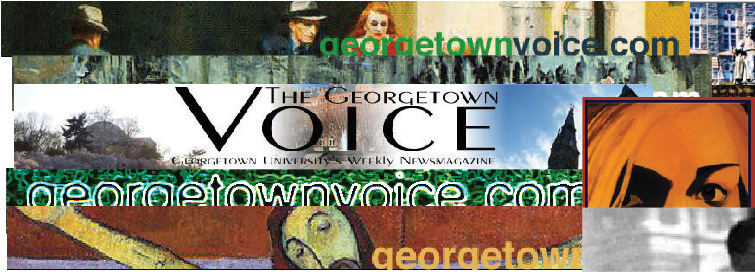Within 16 pages, the Oct. 22, 2009 issue of the Voice housed the feature, “A History of One-night Stands: Comedy at Georgetown,” the news clip, “Shot Fired in McDonough Bathroom,” and the Voices piece, “Tour de Georgetown: Cyclist Pops the G’town Bubble.”
“The Voice definitely produces a lot of professional writers and journalists, and I think that’s because of the attitude we take towards our work,” Leigh Finnegan (COL ’13), editor-in-chief in fall 2012, wrote. “But we also once put out an entire issue about sharks because it was April Fool’s Day. That kind of thing.”
Since its inception in 1969, The Georgetown Voice has maintained a few key characteristics regarding its journalistic focus and culture. Our editorial section has always worked from an explicitly liberal perspective, we cover both Georgetown and D.C. topics with an eye toward national movements, and we’re still the most laid-back (and best) publication on campus.
Notwithstanding the observed continuities of the Voice, the paper has also undergone some major changes over the years, particularly in the last ten years. Whether it’s the shift from weekly to bi-weekly production or the adoption of glossy paper in lieu of the pulpy exterior, there have been fundamental alterations to our structure and culture.
How have we operated in the Age of Information? Here are a few things we’ve noticed about the Voice over the last decade.
Bi-Weekly, Better-Looking
If you pick up a copy of the Voice today, the first thing you’ll notice is a chic exterior with a colorful, distinctive pattern on the cover. At the beginning of the decade, our paper featured eye-catching cover stories, centered around the most important news of the week. But now, our covers are filled with distinctive, artistic flourishes. The shift to glossy paper in 2015 was accompanied by a movement to bi-weekly, rather than weekly, print production, due to pressures from GUSA to reduce printing costs and move online.
The alteration was more than just a logistical decision; it reflected a change in our publication’s focus. The significance of the remodeling is not lost on former staffers and editors, who said the change was a watershed moment in the history of the newsmagazine.
“It shifted what we were focusing on in print to less news and event coverage and a little more broader, bigger stories and things that could hold two weeks and stand up over a longer period of time,” said Liz Teitz (COL ’16), former news editor.
Alex Boyd (COL ’18), editor-in-chief in spring 2018, noticed a significant shift in the quality of reporting as a result of the structural change. Before, Boyd said, the harried process of producing weekly issues had hurt the quality of the Voice.
“I think our professionalism suffered because of that, too, because it was absolutely quantity over quality,” he said.
The weekly grind of production took a toll on the organization, said Chris Almeida (COL ’16), the editor-in-chief in fall 2015. The long Wednesday production nights left staffers and editors too exhausted to do their best work.
“That’s tough, when you’re taking a lot of people writing for the first time and the entire issue hinges on this one cover story,” Almeida said. “You have to turn it around in a week, and doing that is really difficult. It’s just not healthy, not going to help you do your best stuff.”
The shift to a bi-weekly format and glossy paper shaped the Voice’s print content for the second half of the decade. But just as important—though several years earlier—was the Voice’s exploration of new and creative ways to use the internet.
Multimedia & Online Presence
The Voice has grown to use the internet as a companion to our print issues, a transition mirrored in the national media landscape. Even in 2010, the magazine was almost entirely in print, not relying on other forms of media to meaningful degree. But today, the Voice publishes the majority of its content, particularly breaking news, features 12 regularly scheduled podcasts, and engages its audience with Twitter, Instagram, and Facebook.
The changes at the Voice are a microcosm of the nationwide shift in how Americans consume media. According to a Pew Research Poll from 2016, just 20 percent of American adults “often get news from print sources,” compared to 38 percent who get news from online sources and 57 percent from television.
This change in Americans’ consumption patterns isn’t a death sentence for journalism as we know it, but a challenge for us to innovate new ways to draw in readers. The internet allows for a flexibility not available to Voice staffers earlier in the decade. One moment, we might be recording a Stripped podcast about the role of fashion in Colin Kaepernick’s protest of police brutality. The next, the conversation might shift to a contentious debate over our reactions to new movie trailers on the Halftime leisure blog.
“I think the way online works now makes sense, and I’m glad we made that switch,” Almeida said. “It was really, really overdue.”
Michael Trimarchi, the adviser to campus media groups over the decade, said the Voice has been particularly effective at taking advantage of online resources.
“Faced with the budget cuts of a few years ago and the loss of two issues a month, putting most of the breaking content online and using the newsmagazine as a place to put in feature stories, I think, shows in a good way how to use the internet,” Trimarchi said.
Change in Tone, So Long, Vox
It was as if millions of Voicers had cried out in snark, and suddenly were silenced.
The decision to disband Vox Populi, the Voice’s daily blog on culture, sports, politics, and everything in between from 2006 to 2015, was timely and perhaps sorely needed. However, the blog’s wacky, acerbic, yet also journalistic style still speaks to our publication’s ethos. Finnegan recounted one memorable story exemplifying the idiosyncrasies of Vox that buttressed the Voice’s mainstream print content: the bust of a drug lab in the freshman dorm Harbin Hall.
“[Vox] was where we broke news, and it was really widely read and commented on in Georgetown and beyond,” Finnegan wrote. “[Vox] got so many comments that they had to disable them.”
Part of Vox’s appeal was its breadth of coverage. A typical day on the blog addressed issues ranging from North Korean defectors speaking at an on-campus panel to the appearance of a Georgetown alumna on Shark Tank to promote the Boobypack: “the only fanny pack for your rack.” Like a box of chocolates left out in the Darnall common area, you never knew what you were going to get with Vox.
“We tried to maintain that combination of serious journalism, general pop culture snobbery, and irreverence that I think was pretty characteristic at the time,” Finnegan wrote.
However, despite Vox’s popularity and status as an icon of the Voice, its editors were able to spend less time maintaining its quality in the mid-2010s, and the blog’s quality suffered. The Voice made the decision to end Vox’s reign in 2015.
“Having a snarky, clever blog was good, but if you can’t keep up the resources to keep it up, you have to get rid of it,” Almeida said.
In its place, Halftime, established in 2014, now conveys the same irreverent, yet urgent, tone that the Voice carried for years with Vox. Though the format of Halftime differs from that of Vox—it has more long-form, opinion pieces than Vox’s Gawker-y style offered—it still serves as the Voice’s most creative outlet and often a “gateway drug” into the publication.
There are no guidelines for Halftime, just one rule: Halftime is Halftime, baby.
The Party After the Funeral
“Late-night police pursuit costs Georgetown magazine its newsroom” read the headline of the Student Press Law Center’s article on the escapade that started the Voice’s turbulent love affair with Leavey 424. The Washington Post and The Hoya also covered the spectacle (the latter with a healthy dose of schadenfreude).
The well-documented details are as follows: As Hurricane Irene hit D.C. in late August 2011, three Voicers attempted to evade campus police who told them to exit Leavey in case loose shingles fell due to the weather. After locking themselves in the old office, Leavey 413, the students pursued their escape plan. They crawled above the ceiling tiles, likely markered with names of editors-in-chief past, and shimmied above multiple neighboring offices.
Their plan, as it turned out, was far from flawless. And it was costly, earning the three former Voicers criminal charges over $1,000 in damages to ceiling tiles across several offices, and an involuntary move to the smaller office down the hall for the rest of the Voice staff.
“It was a huge blow to all of us,” Finnegan wrote. “Most practically speaking, that [old] office was barely big enough for all of the people and computers we had. The new one was so much smaller that when we first saw it we didn’t know how we were going to be able to put out a paper.”
The old office also had a separate room for the editor-in-chief and managing editor. With the shift, all editorial meetings had to be held at the central table, losing any sense of privacy. More importantly, Leavey 424 did not feel like a home.
“The new one was so small and bare and sad,” Finnegan wrote. “It felt like losing such a big part of our organization.”
While the Voice has come to love its new digs, the immediate response from the paper was disbelief and indignation. Gavin Bade, editor-in-chief in fall 2013, christened the new office by writing “this office sucks” on a ceiling tile, next to his name.
“The old office also had so much institutional history,” Finnegan wrote. “There were dozens of past covers hung up on the walls, and other decorations and pieces of memorabilia that had accumulated over the years.”
The Voice was given two weeks to evacuate the old office.
“I remember our last production night in the old office, when we took down the decorations and threw out most of them,” Finnegan wrote. “It had a very ‘party after a funeral’ kind of vibe.”
Punishing the entire paper for the actions of a few drew protests from the staff, past and present. A protest letter to the administration garnered 57 signatures from alumni. The Hoya called for a reconsideration of the punishment. Even with this outpour of support and appeals to Media Board over the semesters to follow, the university did not reverse its sanction, and the Voice remains in the snug office outside the Leavey elevators.
“I think we did a great job at making the new office our own and adapting to our new space,” Finnegan wrote. “It slowly started to accumulate decorations and feel more like home.”
Despite the nostalgic and comical way it’s repeated to newer staffers as time passes, the anecdote is a crucial reminder of the paper’s relationship with the university. At the time, some Voicers wondered if the forced move was a reaction to the Voice’s criticisms and investigations of the administration.
“And if that’s the reason we were punished, then fine—biting the hand that feeds isn’t the wisest thing to do,” Finnegan wrote, “but it’s the right thing journalistically.”
Institutional Memory
Because most staffers are involved with the Voice for a maximum of eight semesters, the paper has a short institutional memory. This fosters a culture of Voice lore passed down from older members to younger through the years. For example, seniors remember stories of the 2015 “takeover” as told in whispers in the corners of the office or in shouts over a beer. Another great Voice tale is the infamous police chase that led to our office switch. Younger staffers also rely on the older generation to fill them in and shed light on Voice traditions (like choosing the most attractive person in the room upon one’s first mosey to “the green chair”).
Institutional memory plays a role in maintaining—and understanding the evolution of—the paper’s culture. Voice staffers who joined the publication in 2015 heard about the often antagonistic relationships between different sections. Staffers who joined in 2018, however, are surprised by this mild turf warfare.
Naturally, cultures go through cycles. And for an organization whose institutional memory is so short, culture can change rapidly. Despite the ebbs and flows of the last decade, the spirit of the Voice has remained the same. Teitz partly attributes this to the laid-back, cross-sectional culture: In other words, you get to “choose your own adventure.”
“We really tried not to take ourselves too seriously—trying to come up with alliterative or punny headlines, that kind of thing,” Finnegan said. “But we were always really proud of the journalism we put out.”
“We take what we do seriously, but not ourselves too seriously,” Almeida said.
Digging Up the Voice
As current staffers pored over past print issues while preparing for this 50th issue, there were many exclamations of “Oh! We used to have a column on drinking!” and amused disbelief at ads such as the 2009 one for Vox Populi that read, “Snarky, Sexy, Scoops. Want more?”
To the dismay of some staffers, gone are the haiku reviews, the crossword puzzles (and the envied position of “Crossword Editor”). Gone, too, are the horoscopes and the film quotes on the leisure page headers. The masthead no longer has a fax machine number on it, the role of a literary editor, or the logo of a former sponsor, the Center for American Progress.
Other fun tidbits we found included every installment of the collaborative romance mystery series, “50 Shades of Blue and Gray.”
Gone, too, is the cartoon section known as “Page 13.” Some of the drawings have retained their humor through the years. Some are shockingly misogynistic, including biting headlines and captions. Comparing these cartoons to what we would publish today made the change in Voice culture—and culture at large—tangible for currents staffers looking through the archives.
In 2015, the Voice published an offensive cartoon that depicted two white, male GUSA candidates ‘beating a dead horse’ that represented one black and one female GUSA candidate. The response to the cartoon was swift. Amid public outcry and widespread condemnation, including a protest in Red Square, the school called a campus community meeting on diversity and the Voice halted Page 13.
***
Physically, the Voice feels different today. It is smooth and its colors pop out from newsstands. The paper is glossy enough to catch the light (at least the light that finds its way in from the office’s singular window). The newsroom still has its energetic, ragtag feel, and old cartoons, issues, Twitter battles with The Hoya, and artwork dot the walls (and remain resilient, despite the biannual sprinkling of champagne).
Now, the office houses podcast equipment and runs on an intense Google calendar to coordinate meeting times. Pithy headers aside, the editorial section still opens the newsmagazine with a strongly liberal stance that harkens back to its founding in 1969. And there is an undeniable sense of pride in being a member of the Voice, whether you dabble in leisure or attend every meeting from business to news.
“The Voice was the first place that I had the chance to try out writing and reporting, and where I realized this is what I want to do,” Teitz said. “This is it.”




